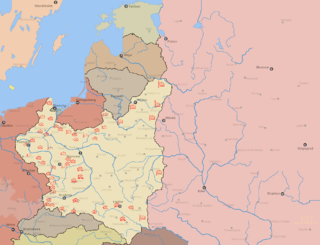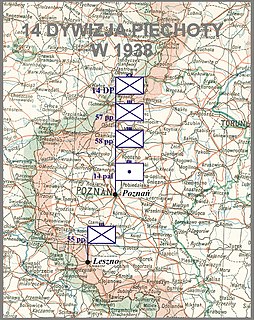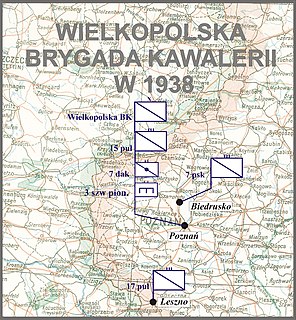
The charge at Krojanty, battle of Krojanty, the riding of Krojanty or skirmish of Krojanty was a cavalry charge that occurred during the invasion of Poland in the Second World War. It took place on the evening of 1 September 1939 near the Pomeranian village of Krojanty. Polish soldiers advanced east along the former Prussian Eastern Railway to railroad crossroads 7 kilometres from the town of Chojnice (Konitz) where elements of the Polish cavalry charged and dispersed a German infantry battalion. Machine gun fire from German armoured cars that appeared from a nearby forest forced the Poles to retreat. However, the attack successfully delayed the German advance, allowing the Polish 1st Rifle battalion and Czersk Operational Group to withdraw safely.

This article discusses the Polish order of battle during the invasion of Poland. In the late 1930s Polish headquarters prepared "Plan Zachód", a plan of mobilization of Polish Army in case of war with Germany. Earlier, the Poles did not regard the Germans as their main threat, priority was given to threat from the Soviets.

The siege of Warsaw in 1939 was fought between the Polish Warsaw Army garrisoned and entrenched in Warsaw and the invading German Army.

The Battle of the Bzura was the largest Polish counter-attack of the German Invasion of Poland, fought between the 9th and 19th of September. The battle took place west of Warsaw, near the Bzura River. It began as a Polish counter-offensive, which gained initial success, but the Germans outflanked the Polish forces with a concentrated counter-attack. This weakened Polish forces and the Poznań and Pomorze Armies were destroyed. Western Poland was now under German rule. The battle has been described as "the bloodiest and most bitter battle of the entire Polish campaign". Winston Churchill called the battle an "ever-glorious struggle".

The Volhynian Cavalry Brigade was a Polish cavalry brigade, which saw action against the invading Germans during the Invasion of Poland, a part of World War II. Raised from recruits in the area of Wołyń, the division was posted to the Łódź Army. During several desperate counter-attacks, the brigade suffered heavy casualties near Łódź. It was commanded by Colonel Julian Filipowicz. Most notably, the unit took part in one of the first battles of the German invasion of Poland, the battle of Mokra.

The Southern Front was one of two fronts of the Polish Army created during the Invasion of Poland of 1939 against the allied forces of Nazi Germany and Soviet Union. It was established on September 12 out of the Polish Armies Karpaty and Kraków, as well as several military units created behind the front-lines.

The Battle of Radom, also known as the Battle of Iłża, was part of the Invasion of Poland during the Second World War. It lasted from 8 September 1939 to 9 September 1939. Polish troops of the Prusy Army, under General Stanisław Skwarczyński, defended the city of Iłża and the road from Sandomierz to Radom. The Poles were not ready to meet head on overwhelming German XV Army Corps, and were easily defeated after two days of fighting. Prusy Army, in the aftermath of the battle, ceased to exist. Some of the army's units joined other tactical groupings of the Polish armed forces.

The Battle of Jordanów took place on 1–3 September 1939, during the Invasion of Poland and the opening stages of World War II. It was fought between the German XVIII Panzer Corps of Gen.E.Beyer and the Polish 10th Motorized Cavalry Brigade under Col. Stanisław Maczek.
The World War II Battle of Krasnobród took place on 23 September 1939 near the town of Krasnobród. It was fought between the forces of the Polish Army and the German Wehrmacht during the Invasion of Poland. It was one of the last battles in European warfare in which cavalry was used on both sides.
The Battle of Wola Cyrusowa took place on 8 September 1939 near the village of Wola Cyrusowa near Stryków in Poland, during the September Campaign. It was fought between the forces of the Polish Piotrków Operational Group under Gen. Wiktor Thommée and the German 10th Infantry Division. In the effect of a successive delaying action, the Polish forces managed to regroup and withdraw eastwards while at the same time inflicting heavy losses on the opposing unit. However, their victory was only a temporary setback for the Nazi invasion of Poland.

Battle of Lasy Królewskie refers to the battle on 1 September 1939 near Janowo and Krzynowłoga Mała during the Battle of the Border of the Invasion of Poland.
The 16th Pomeranian Infantry Division is a military unit of the Polish Army. It was first raised on 16 August 1919 during the Polish uprising, before going on to serve during the subsequent war with the Bolsheviks. At the start of World War II the division fought briefly against the advancing German Army before being destroyed on 19 September 1939 after being surrounded in the Kampinos Forest. The division was raised once more in 1945 following the Soviet takeover of Poland; however, it did not see further action during the war. Afterwards it continued to serve, undergoing a number of changes in name and role. Today, it exists as the 16th Mechanised Division.

Battle of Grudziądz was a military engagement between German and Polish forces during the early days of the Invasion of Poland in September 1939. It started on 1 September and ended with a German victory on 4 September. German historiography has dealt with the fighting in the larger context of the Battle of Tuchola Forest.

The Battle of Mikołów refers to the border engagement on September 1 and 2, 1939, that took place in the area of the town of Mikołów, which is located in the Polish part of Upper Silesia, during the early stages of the Invasion of Poland in the Second World War.

14 Greater Poland Infantry Division was a unit of the Polish Army in the interbellum period, which took part in the Polish September Campaign.

Pomeranian Cavalry Brigade was a cavalry unit of the Polish Army in the interbellum period. It was created on April 1, 1937 out of the Cavalry Brigade "Bydgoszcz". Its headquarters were stationed in Bydgoszcz and the brigade consisted of these units:

Wielkopolska Cavalry Brigade was a cavalry unit of the Polish Army in the interbellum period. It was created on April 1, 1937 out of the Cavalry Brigade "Poznań". Its headquarters were stationed in Poznań and the brigade consisted of these units:

Podolska Cavalry Brigade was a cavalry unit of the Polish Army in the interbellum period. It was created on April 1, 1937 out of the 6th Independent Cavalry Brigade. Its headquarters were stationed in Stanisławów and the brigade consisted of these units:
The Battle of Piotrków Trybunalski was a battle in the Invasion of Poland from the 5 to 6 September 1939, which involved Polish and German tank formations.
The Raid on Fraustadt was a military raid, carried out by the Polish Army on September 2, 1939, second day of the Invasion of Poland. Polish forces attacked Wehrmacht positions in and around the town of Fraustadt, in the Province of Silesia, Free State of Prussia.













